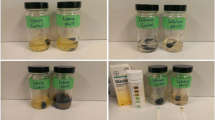Summary
A blown bitumen Mexphalte R 90/40 with a high content of saturated hydrocarbons was degraded by several microorganisms to the same extent. In batch cultures ofSaccharomycopsis lipolytica, maximal biodegradation was estimated to be about 9% w/w, 3.2·10−3 g/cm2 and 3.1·10−3 cm of degraded bitumen. The Mexphalte R 90/40 degradation rate was closely coupled to biofilm formation. The microbial activity concerned predominantly the oxidation of saturated hydrocarbons. A direct distillation bitumen 80/100 with a low content of saturated hydrocarbons and a high content of aromatic hydrocarbons and resins was more resistant to biodegradation.
Similar content being viewed by others
References
Ait, N., and Pedersen, B. M., Microbial degradation of bitumen used for the conditioning of low and medium level radioactive waste in: Testing, Evaluation and Shallow Land Burial of Low and Medium Radioactive Waste Forms. Eds. W. Krischer and R. Simon. Harwood Academic Publishers, Brussels and Luxembourg 1984.
Atlas, R. M., Microbial degradation of petroleum hydrocarbons: an environmental perspective. Microbiol. Rev.45 (1981) 180–209.
Barletta, R. E., Bowerman, D. S., Davis, R. E., and Shea, C. E., Biodegradation testing of bitumen. Mat. Res. Soc. Symp. Proc. (1987) 399–405.
Brunner, C., Wolf, M., and Bachofen, R., Enrichment of bitumen-degrading microorganisms. FEMS Microbiol. Lett.43 (1987) 337–344.
Buckley, L. P., Glegg, B. C., and Oldham, W. K., Microbial activity on bituminized radioactive waste. Radioact. Waste Manag. nucl. Fuel Cycle6 (1985) 19–36.
Dostalek, M., Munk, V., and Volfova, O., Cultivation of the yeastCandida lipolytick on hydrocarbons. I. Degradation of n-alkanes in batch fermentation of gas oil. Biotechnol. Bioeng.10 (1968) 33–43.
Herbes, S. E., Rates of microbial transformation of polycyclic aromatic hydrocarbons in water and sediments in the vicinity of a coalcoking wastewater discharge. Appl. envir. Microbiol.41 (1981) 180–209.
McKinley, I. G., West, J. M., and Grogan, H. A., An Analytical Overview of the Consequences of Microbial Activity in a Swiss HLW Repository. NAGRA report 85–43, 1985.
Munoz Cebrian, J. M., Microbial deterioration of bituminous materials: selection of microorganisms with specific metabolic capacity on hydrocarbons, in: Biodeterioration 5, p. 472–483. Eds T. A. Oxley and S. Barry. John Wiley Sons Ltd, London 1983.
Oudot, J., Le bilan du carbone dans une expérience de biodégradation bactérienne d'un pétrole brut. Envir. Pollut.20 (1979) 177–187.
Oudot, J., Rates of microbial degradation of petroleum components as determined by computerized capillary gas chromatography and computerized mass spectrometry. Mar. envir. Res.13 (1984) 277–302.
Pritchard, P. H., Ventulo, R. M., and Suflita, J. M., The microbial degradation of diesel oil in multistage continuous culture systems, in: Proceedings of the 3rd Int. Biodegradation Symposium, p. 67–78. Eds I. M. Sharpley and A. M. Kaplan. Applied Science Publishers Ltd, London 1976.
Roffey, R., and Hjalmarsson, K., Microbial processes in the final repositor the silo part. Theoretical approach and preliminary experiments on the biodegradation of bitumen. Part. 1. FOA-C-40 172-B4 (1983).
Rontani, J. F., Bosser-Joulak, F., Rambeloarisoa, E., Bertrand, J. C., Giusti, G., and Faure, R., Analytical study of asthart crude oil asphaltenes biodegradation. Chemosphere14 (1985) 1413–1422.
Walker, J. D., Colwell, R. R., and Petrakis, L., Biodegradation rates of components of petroleum. Can. J. Microbiol.22 (1976) 1209–1213.
Westlake, D. W. S., Jobson, A., Philippe, R., and Cool, F. D., Biodegradability and crude oil composition. Can. J. Microbiol.20 (1974) 915–928.
Wolf, M., Mikrobieller Abbau von Bitumen. NAGRA report 89-14, 1989.
Wyndham, R. C., and Costerton, J. W., In vitro microbial degradation of bituminous hydrocarbons and in situ colonization of bitumen surfaces within the Athabasca oil sands deposit. Appl. envir. Microbiol.41 (1981) 791–800.
Zobell, C. E., and Molecke, M. A., Survey of microbial degradation of asphalts with notes on relationships to nuclear waste management. Sand (1978) 78–1371.
Author information
Authors and Affiliations
Rights and permissions
About this article
Cite this article
Ait-Langomazino, N., Sellier, R., Jouquet, G. et al. Microbial degradation of bitumen. Experientia 47, 533–539 (1991). https://doi.org/10.1007/BF01949873
Published:
Issue Date:
DOI: https://doi.org/10.1007/BF01949873




